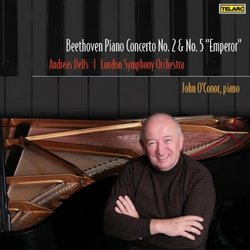Album DescriptionBeethoven premiered the Piano Concerto in B-flat major at his first Viennese public appearance in which he shared the bill with Antonio Cordellieri. Beethoven later revised the work extensively for a concert in Prague; this is the version that is known today. The original one has vanished. "The Second Piano Concerto is a product of the Classical age, not just in the date but also in the technique, expression and attitude," says Richard Rodda in the liner notes. "A traditional device - one greatly favored by Mozart - is used to open the concerto, a forceful fanfare motive immediately balanced by a suave lyrical phrase." The second movement is full of rich textures and is more like a song and is a reminder that Beethoven was one of the finest keyboard improvisers of his day. The finale is a rondo based on a theme that is immediately introduced by the soloist. Unlike the Second Piano Concerto, the 5th came out of one of the most difficult times during Beethoven's life. The year was marked by Napoleon's invasion, which sent residents of Vienna scurrying and Beethoven into the basement of his brother's house. On July 29, 1809, he wrote to his publisher Breitkopf und Härtel, "We have passed through a great deal of misery. I tell you that since May 4, I have brought into the world little that is connected; only here and there a fragment. The whole course of events has affected my body and soul...What a disturbing, wild life around me; nothing but drums, cannons, men, misery of all sorts." By the end of this year, a great musical work was complete, Beethoven's "Emperor" concerto. The title "Emperor" attached itself to the E-flat concerto very early, though it was not of Beethoven's doing. The nicknamed "Emperor" concerto opens with broad chords for orchestra answered by piano before the main theme is announced by the violins. When the orchestral tutti embraces the rich variety of the secondary themes a development ensues with "the fury of a hail storm," wrote British musicologist Sir Donald Tovey. The second movement begins with a chorale of strings. The Adagio leads directly into the finale, a rondo with sonata elements and the piece ends with the magical sounds of drum taps accompanying the shimmering piano chords and scales.


 Track Listings (6) - Disc #1
Track Listings (6) - Disc #1